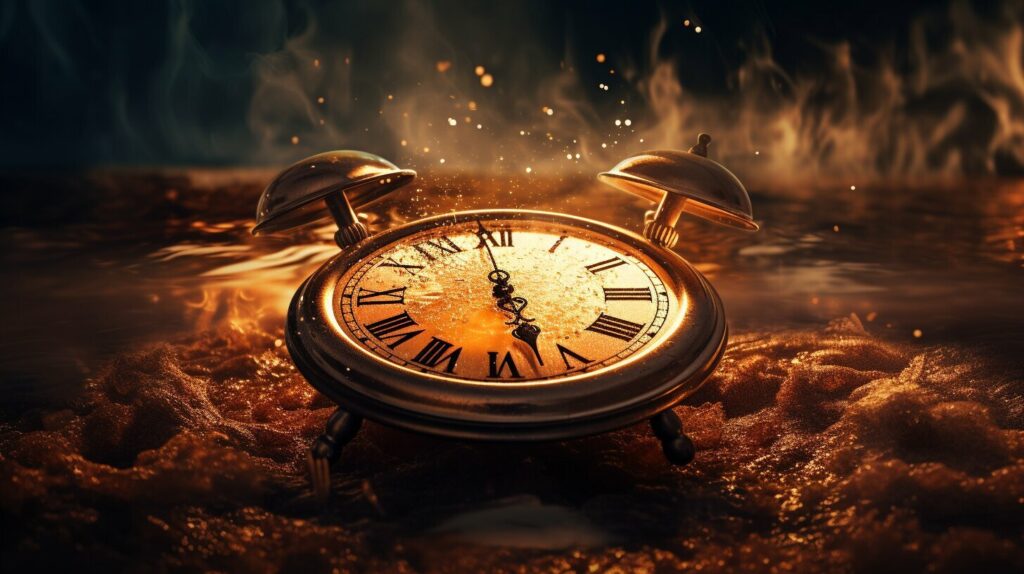*This post may contain affiliate links for which I earn commissions.*
Have you ever woken up from a dream feeling like you experienced hours, or even days, while only a few minutes passed in the real world? How long is one second in a dream? How long do dreams last? Questions are often asked.
Our perception of time in dreams is a fascinating and mysterious phenomenon that has long intrigued scientists, psychologists, and dreamers alike.
Key Takeaways:
- Dream time perception is a complex and intriguing phenomenon that has fascinated experts and individuals for centuries.
- Time dilation and distortion are common occurrences in dreams, making measuring how long one second feels in a dream is difficult.
- The science behind dream time involves examining brain activity during dreaming, particularly during Rapid Eye Movement (REM) sleep.
- Dream time can provide insights into personal growth and creativity, making it an area worth exploring for anyone interested in their inner world.
Understanding Time Perception in Dreams
Time perception in dreams is a fascinating and complex subject that has intrigued scientists, philosophers, and dreamers for generations. When we dream, time can feel elongated or compressed, and the experience of time can be vastly different from our waking reality.
Dreams are often characterized by a phenomenon known as time dilation, where time can either feel much longer or much shorter than it actually is. For example, in a dream, a single second can feel like an eternity, or hours can pass in what seems like mere moments.
This distorted sense of time in dreams is thought to be related to changes in brain activity during sleep, particularly during the rapid eye movement (REM) phase of sleep when most dreaming occurs.
Time Dilation in Dreams
There are several theories as to why time dilation occurs in dreams. One hypothesis suggests that it is related to the brain’s processing speed during REM sleep, which is slower than in wakefulness, causing time to feel elongated.
Another theory proposes that the brain perceives time differently, less influenced by external stimuli and the constraints of reality.
It is also possible that the emotional content of the dream influences time perception in dreams. Dreams with intense emotions may feel longer, as the brain processes and remembers emotional experiences more vividly than neutral ones.
Measuring Time in Dreams
While it is difficult to measure time accurately in dreams, several studies have attempted to investigate this phenomenon. One study found that participants perceived time as slower in dreams than in waking life, while another study suggested that dream time may be shorter than real-world time.
However, these studies face several challenges, including the subjective nature of time perception and the difficulty of accurately measuring time in dreams. It is also possible that individual differences in dream experiences and sleep cycles may contribute to differences in time perception.

Despite the challenges of measuring time in dreams, research on this topic continues, offering new insights into the nature of consciousness and the brain’s time processing.
In the next section, we will explore the duration of time in dreams and whether dream time correlates with real-time.
The Duration of Time in Dreams
The experience of time in dreams has long been a subject of fascination and intrigue. While it may feel like hours have passed in a dream, the actual duration of time is difficult to measure and often seems distorted or compressed.
Researchers and scientists have attempted to understand the relationship between dream time and real-time, but the subjective nature of dreams makes it a challenging task.
One theory suggests that time in dreams is experienced in a compressed manner, meaning that events occur more quickly than they would in real-time. Another theory proposes that time in dreams is more elastic, with some moments stretching out for an extended time while others seem to pass quickly.
While these theories provide some insight into the experience of time in dreams, the subjective nature of dreams makes it challenging to generalize how time is perceived.
How Long Do Dreams Really Last?
Attempts to measure the duration of time in dreams have been made using various methods, including physiological measurements and self-reports. One study used brainwave recordings to estimate the duration of dream events, while another asked participants to estimate the length of their dreams.
However, these methods have limitations, and comparing the subjective experience of time across different individuals and dreams is challenging.
It is also worth noting that the experience of time in dreams can vary depending on the type of dream. For example, nightmares may feel like they last longer than more pleasant dreams, while lucid dreams, where the dreamer is aware they are dreaming, may have a different experience of time altogether.

Despite the challenges associated with measuring the duration of time in dreams, some research suggests that the experience of time in dreams may be related to REM sleep cycles.
Studies have shown that dream time tends to occur in short bursts coinciding with REM sleep cycles, which could provide insight into the relationship between sleep and time perception in dreams.
Overall, the time experience in dreams remains a fascinating and mysterious aspect of dreaming. While attempts have been made to understand the duration of time in dreams, the subjective nature of the dream state makes it a complex area to study.
Further research may provide more insight into the relationship between dream time and real-time, allowing us better to understand this intriguing aspect of the human experience.
Time Perception in Lucid Dreams
Lucid dreaming is a unique state of consciousness where the dreamer is aware that they are dreaming, allowing for a level of control and manipulation of the dream experience. Time perception in lucid dreams can vastly differ from regular dreams or waking reality.
Studies have shown that time perception in lucid dreams can be altered, with lucid dreamers reporting more accurate time duration estimations than regular dreams.
In fact, some lucid dreamers have reported experiencing seemingly hours-long dreams that only lasted a few minutes in waking reality.
Lucid dreamers can also manipulate time within their dreams, slowing it down or speeding it up at will. This can allow more exploration of dream worlds and deeper immersion in the dream experience.
Overall, the unique aspects of time perception in lucid dreams make it a fascinating field for further research and exploration.

Time Distortion in Sleep
Time distortion in sleep is a common phenomenon, where time can feel subjective or compressed during dreaming. This experience is often attributed to the nature of REM sleep, the stage of sleep where most dreaming occurs.
During REM sleep, the brain is highly active, and the body is paralyzed, preventing people from acting out their dreams.
One theory suggests that the brain’s activity during REM sleep causes time perception to become more fluid, resulting in time appearing to move more quickly or slowly than in waking life.
This fluidity of time allows dreamers to experience a full range of emotions and events, seemingly compressed into a short period.
Factors such as age, sleep quality, and medication use can also influence time perception in dreams. For example, older adults experience shorter dream sequences, while individuals with sleep disorders may have distorted time perception due to disrupted sleep patterns.

It’s important to note that time distortion in sleep is not always negative. Some individuals report feeling they have had complete, enriching experiences during a single dream, even though it may have only lasted a few minutes in real-time.
Overall, time distortion in sleep is a complex and intriguing phenomenon that fascinates scientists and individuals alike.
The Science Behind Dream Time
The study of dream time is a fascinating field that has intrigued scientists and researchers for centuries. While the experience of time in dreams is subjective, a growing body of scientific research sheds light on this mysterious phenomenon.
A critical factor contributing to dream time perception is the brain activity during the dreaming state. During rapid eye movement (REM) sleep, the brain is highly active and experiences a range of neural activity similar to the waking state.
This includes the activation of the prefrontal cortex, which is responsible for executive functioning, such as decision-making, attention, and planning.
Additionally, studies have shown that the level of emotional arousal can influence the subjective experience of time in dreams during the dream. For example, nightmares and highly emotional dreams are more prolonged than non-emotional dreams.
Another exciting aspect of dream time perception is the phenomenon of time dilation, where time can feel either elongated or compressed during dream experiences. This can be attributed to the brain’s ability to manipulate and distort time perception without external stimuli.
As research in this field continues to evolve, scientists are gaining a deeper understanding of the mechanisms behind dream time perception. This may one day lead to innovative therapies and interventions that can improve our sleep quality and overall well-being.

Psychological Perspectives on Dream Time
Dreams have long fascinated psychologists, who see them as windows into the unconscious mind. Psychological theories abound when it comes to the experience of time in dreams, each offering a different perspective on the mysteries of dream time.
Father of Psychoanalysis – Sigmund Freud
Sigmund Freud, the father of psychoanalysis, viewed dreams as symbolic expressions of unconscious desires and believed that the experience of time in dreams was closely linked to the content of the dream itself.
According to Freud, dreams allow us to explore our repressed desires in a safe and anonymous environment, and the time we experience in dreams reflects the intensity of our unconscious desires.
| Key Points on Freudian View |
|---|
| • Time in dreams is closely linked to the content of the dream itself |
| • Dreams allow us to explore our repressed desires in a safe and anonymous environment |
| • The time we experience in dreams is a reflection of the intensity of our unconscious desires |
Carl Jung and the Collective Unconscious
Carl Jung, a student of Freud, took a different approach to dream interpretation, viewing dreams as a means of accessing the collective unconscious – a realm of archetypes and symbols all humans share.
Jung believed that the experience of time in dreams reflected different stages of psychological development and that time in dreams was a reflection of the individuation process – the ego’s journey toward self-realization.
| Key Points on Jungian View |
|---|
| • Dreams are a means of accessing the collective unconscious |
| • Time in dreams reflects different stages of psychological development |
| • Time in dreams is a reflection of the individuation process |
Cognitive Science and Dream Time
In recent years, cognitive scientists have taken an interest in the experience of time in dreams, seeking to understand how the brain processes temporal information during dream states.
Research has revealed that the parts of the brain responsible for processing time perception are active during REM sleep and that time in dreams is likely experienced in a way that is similar to real-life time perception.
| Key Points on Cognitive Science View |
|---|
| • Cognitive scientists seek to understand how the brain processes temporal information during dream states |
| • The parts of the brain responsible for processing time perception are active during REM sleep |
| • Time in dreams is likely experienced in a way that is similar to real-life time perception |
As research and theories continue to evolve, studying dream time remains a fascinating field for psychologists and dream enthusiasts alike.
Cultural and Historical Views on Dream Time
Dreams have long been a subject of fascination and interpretation across many cultures and historical periods. In ancient Egypt, dreams were considered messages from the gods and were recorded for their prophetic value.
The Chinese also believed in the divinatory power of dreams and developed the practice of dream interpretation as early as the 5th century BC.
Many Native American tribes believed that dreams were a means of connecting with the spiritual world and sought guidance from their dream experiences.
In modern Western society, the interpretation of dreams has been heavily influenced by the work of Sigmund Freud and Carl Jung. Freud believed dreams were a product of the unconscious mind and could be interpreted to reveal repressed desires and conflicts.
Jung expanded upon this idea and developed the concept of archetypes, which he believed were universal symbols that held meaning in both waking and dream states.
Artists and writers have also drawn inspiration from their dream experiences. Salvador Dali famously incorporated dream imagery into his surrealist paintings, while authors like Stephen King and J.K. Rowling have credited their dreams with inspiring their creative works.
Overall, the cultural and historical views on dream time highlight the significance of dreams in human experience and the value placed on the messages and symbolism that can be found within them.

Personal Experiences and Anecdotes
Our experiences of time in dreams are highly subjective and vary from person to person. Some people report feeling like their dreams last for hours, while others feel like they only last for a few minutes.
The duration of a dream can also be influenced by the content of the dream, with more vivid or intense experiences feeling longer than quieter or more mundane dreams.
I have experienced both time compression and time dilation in my dreams. In one dream, I felt like I was stuck in a loop, repeating the same few seconds repeatedly, which felt like hours of endless repetition. In another dream, I felt like I had lived an entire lifetime, experiencing a full range of emotions, relationships, and life events, all in what must have been a few minutes of real-time.
Despite the inconsistencies in how time is experienced in dreams, it remains a fascinating and mysterious aspect of the human mind. As we continue to explore the depths of our unconscious, we may gain a deeper understanding of the nature of time and how it shapes our perception of reality.

Techniques for Enhancing Dream Time Awareness
Several practical techniques can be utilized for those interested in exploring and enhancing their awareness of dream time.
Dream Journaling
Dream journaling involves writing down the details of your dreams as soon as you wake up. This helps to improve dream recall and develop the ability to recognize dream signs, which are recurring themes or events in your dreams.
By becoming more aware of these signs, you can increase the likelihood of becoming lucid and manipulating dream time.
Reality Checks
Reality checks involve questioning the reality of your surroundings throughout the day. For example, asking yourself if you are dreaming or performing simple tasks like looking at your hands can increase your awareness of dream time and help you recognize when you are in a dream state.
Meditation
Meditation can help improve focus and concentration, translating to increased awareness and control during dream time. By practicing mindfulness and relaxation techniques, you can develop the ability to enter a lucid dream state and manipulate the experience of time in dreams.

Remember, the key to enhancing dream time awareness is practice and patience. Incorporating these techniques into your daily routine allows you to develop a deeper understanding and control of your dreams, leading to personal growth and creativity.
The Role of Dream Time in Personal Growth and Creativity
Exploring dream time can have significant benefits for personal growth and creativity. Dreams have long been a source of inspiration for artists, writers, and thinkers, providing a rich landscape for exploring the depths of the unconscious mind.
By tapping into dream time and exploring the symbolism and meaning behind our dreams, we can better understand ourselves and our place in the world.
One way to use dream time for personal growth is through dream journaling. Recording our dreams in a journal can help us better understand the patterns and themes that emerge in our dreams. We can gain insights into our deepest desires, fears, and aspirations by analyzing these patterns.
Dream journaling can also help us identify and work through emotional and psychological issues, providing a space for reflection and introspection.
In addition to personal growth, exploring dream time can also enhance creativity. Dreams provide a fertile ground for exploring new ideas and perspectives, offering a break from our waking reality and allowing us to tap into our imagination.
We can find inspiration for new creative projects or approaches to existing ones by paying attention to the details and symbolism in our dreams.
Lucid dreaming, or the ability to control and manipulate our dreams, can also be a powerful tool for enhancing creativity. By becoming aware of the dream state and practicing techniques for controlling our dreams, we can create a space for experimenting with new ideas and stretching our creative boundaries.
Overall, exploring dream time can be valuable for personal growth and creativity. Whether through dream journaling, lucid dreaming, or simply paying attention to the symbols and themes that emerge in our dreams, tapping into dream time can provide a wealth of insights and inspiration.

Conclusion
Exploring dream time can be a fascinating journey into the mysteries of the unconscious mind. Throughout this article, we have delved into the intriguing concept of time perception in dreams, from the phenomenon of time dilation to the challenges of measuring dream time duration.
We have examined lucid dreaming and time distortion in sleep, as well as the scientific, psychological, and cultural perspectives on dream time.
Personal experiences and anecdotes have highlighted the subjective nature of dream time, while techniques for enhancing dream time awareness have been provided for those interested in exploring and cultivating their lucid dreaming abilities.
Moreover, we have explored the potential benefits of accessing dream time for personal growth and creativity. From gaining insights into oneself to finding inspiration for artistic endeavors, dream time can profoundly impact one’s life.
In conclusion, dream time remains an intriguing and mysterious phenomenon that fascinates scientists, psychologists, and individuals alike. We encourage readers to explore their own dream experiences and delve into the mysteries of the unconscious mind.
FAQ
Q: How long do dreams last?
A: The length of dreams can vary. Dreams can last from a few seconds to around 20-30 minutes on average. The exact duration of a dream largely depends on the individual and their sleep stage.
Q: How many dreams do people experience in one night?
A: People experience multiple dreams throughout the night. On average, an individual can have four to six dreams per night. However, it is essential to note that not everyone remembers all of their dreams.
Q: What is the sleep stage in which dreams are most vivid?
A: Dreams are most vivid during the REM (Rapid Eye Movement) sleep stage. This is the stage of sleep characterized by rapid eye movement, increased brain activity, and vivid dreaming. REM sleep is believed to play a crucial role in memory consolidation and emotional processing.
Q: Can dreams occur during non-REM sleep?
A: Yes, dreams can also occur during non-REM (Non-Rapid Eye Movement) sleep stages. However, the dreams experienced during non-REM sleep are usually less vivid and memorable than those during REM sleep.
Q: Why do some people remember their dreams while others don’t?
A: The ability to remember dreams can vary from person to person. Some factors that may influence dream recall include individual differences in dream vividness, sleep quality, and waking up during or immediately after a dream.
Additionally, keeping a dream journal or practicing better dream recall techniques can help improve dream memory.
Q: How long does the average person spend dreaming each night?
A: The average person spends about two hours or more dreaming each night. This dream time is spread across multiple dream episodes during different sleep stages.
Q: What is the correlation between the time spent in REM sleep and dream length?
A: There is a correlation between the time spent in REM sleep and dream length. REM sleep periods tend to lengthen as the night progresses, and the dreams experienced during these longer REM cycles can be more elaborate and detailed.
Q: Are there any interesting facts about dream length?
A: Yes, there are some interesting facts about dream length. For instance, dreams can seem much longer than they actually are. While dreams may last only a few minutes in real-time, they can feel like they go on for hours or even days.
Additionally, studies have shown that individuals with PTSD (Post-Traumatic Stress Disorder) tend to experience longer and more intense dreams.
Q: Is there any meaning to dreams based on their length?
A: The length of a dream does not necessarily determine its meaning. The significance of a dream is subjective and can vary from person to person. It is crucial to consider the content, emotions, and personal associations within a dream when interpreting its meaning.
Q: How can I know how long my dreams last?
A: It can be challenging to know the exact duration of your dreams. Since dreams occur during sleep, time perception is often distorted. However, keeping a dream journal and writing down your dream experiences immediately upon waking can help provide insight into your dreams’ length and content.







